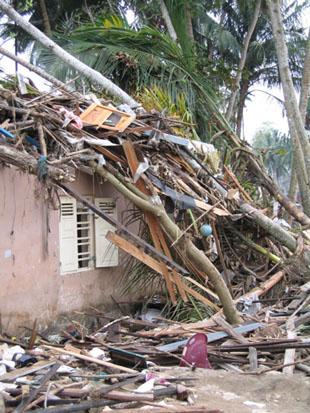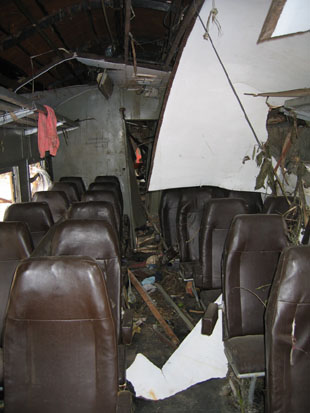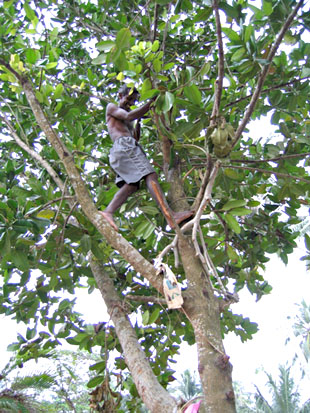In January of 1984, two months shy of my 30th birthday, I explored the west coast of Sri Lanka on one of my first travel assignments. My girlfriend Teri and I started in Colombo, and traveled by bus to the southern tip of the island at Dondra Head: the last landfall until the frozen beaches of Antarctica. Then, as now, Sri Lanka was recovering from the flare-up up civil war, and tourism was beginning to blossom after a tense hiatus. Some of my memories from that visit are still vivid: from walks along the long, lazy beaches of Panadura to visions of the “stilt” fishermen of Koggala, balanced above the surf on precarious wooden posts.
My driver is an elderly man named Chandra, provided by my hosts at Mercy Corps. We leave Colombo at 11 a.m.. The traffic is terrible, and we crawl through a purgatory of packed buses and belching two-stroke tempos. McDonald’s, Pizza Hut, and endless billboards for cell phone service line Galle Road, with the ocean appearing and disappearing on our right. There isn’t a hint of damage; nothing to indicate that this country is in the midst of one of humanity’s worst natural disasters.

South of Moratuwa, beyond the famous Mount Lavinia Hotel, the impact of the tsunami becomes evident. It’s worst along the beach, where the poorest citizens inhabited makeshift wooden houses. Chandra parks the car. I walk over mounds of household flotsam toward the ocean. There are piles of debris everywhere: surreal assemblages of televisions and teddy bears, checkerboards and linoleum flooring, tattered pants and half-filled ledger books. The displaced inhabitants moved amid the chaos, sifting listlessly through what had been back yards and kitchens.
We drive on—until, a mile further south, we seem to cross a line. The traffic thins, and the whole western shoreline is suddenly an expanse of rubble, shattered houses, and bulldozed woodpiles. Chandra holds a hand up to his wizened face, and keeps a running line of dialogue: “Oh, lookÖ. SirÖ See! Ö Tsunami! Sir, lookÖ” It’s not as if he thinks I’m missing anything; he simply needs to express his astonishment, to connect with another soul in the face of so much destruction.
This is where, after two weeks of television footage and magazine photos, it hits home for me. This isn’t news; it’s not a TV drama, or a story with a start, middle, and ending. It’s tens of thousands of unhappy people in the midst of their ruined lives, homeless, waiting for their longest bad dream to end.
Every time we walk amid the destruction, locals wave us over. They want us to see what remains of their lives. This is where their children went to school; this was a restaurant, or post office, or hotel. “Come this way! Come, come!” We hurry ahead, stepping over ragged blocks of cement, broken glass, broken pails. Chandra is barefoot; I’m wearing hiking boots.
On the beach at Panadura, a group of young volunteers from the JVP—Sri Lanka’s communist party—work to untangle what I assume is a fishing net from a rubble of electrical posts. Actually, it’s a volleyball net; this was once a popular playground. They let me take photos, and point to the clean-up they’ve accomplished today.
“Thanks for showing me what you’re doing,” I nod, moving on. “We are not showing,” their leader states pointedly. “We are doing.”
Driving through Payagala, we navigate long stretches where everything seems normal, untouched, before entering zones of utter destruction. “Sir, seeÖ” Chandra points to the train station; it looks like it’s been hit by an asteroid. Now the traffic is bad again—accident up ahead, or a bulldozer—and we’re stuck. Right ahead of us is an ambulance, packed with medications, also trapped. I glance in the back window at a box, reading the bold letters through the glass: KEEP REFRIGERATED.
Beruwala, halfway to the southern port of Galle, was a thriving fishing village. You can still see the boats; they’re well-made, brightly painted, and strewn all over the roadside. Some are snapped in half, while others have simply been flipped over, like beetles. They lay in the surf, belly-up. Piled up this way, the simile is unavoidable; they look like toys, churned to destruction in a soap-filled tub.
The road looks nothing like I remember it; nor does it look anything like it did right after the tsunami. One week ago rubble covered everything, and two major bridges were washed away. The road re-opened just five days ago, Chandra tells me, after a fleet of bulldozers shoved tons of debris, boats, and broken buildings to the side.

We stop for lunch at the Avanhala Restaurant in Bentota. Manager R. G. Jayawardena, a short man with an enormous belly, hands me his business card; it proclaims his Diploma in Journalism. When I press him on this, he opens a file and extracts the snapshots he took of The Queen of the Sea: the packed tourist train that was derailed by the tsunami, with an awful loss of life. They’re not good photographs, but they were taken fresh. If anything, they show that the voyeuristic impulse is universal. Jaywaradena’s images, showing him standing beside the train’s wrecked engine, remind me of the photos people took in San Francisco’s Marina District after the Loma Prieta Earthquake. Such photos are highly prized, for they show us with monuments that are both majestic and temporary, and as spectacular as they are notorious.
We pay our bill and drive onward to Balapitiya, which, Chandra informs me, was a mainly Moslem community. Looking at the egalitarian damage—to the homes of Hindus, Christians and Moslems alike—one puts paid to the notion of a God who takes sides. On the other hand, it’s remarkable to note that, in many towns, the most significant shrines of each religion—a crucifix in Maggona, a meditating Buddha in Akurala, and a statue of Shiva in a Hindu shrine along the road—were miraculously spared. Seeing one example, I’d be tempted to dismiss it as coincidence. But witnessed in nearly every settlement, the sight of these lone shrines, standing amid endless rubble, is enough to make even this cynic hedge his bets.
South of Balapitiya, we enter the northern fringe of Sri Lanka’s tourist mecca: the town of Ambalangoda, famous for its carved and brightly painted wooden masks. The contrast between the two parts of the area—one devastated, the other intact—is maddening. “Why, Sir?” demands Chandra, as if I might know. “Why?”
A few miles south, though, in Akurala, we get part of the answer.
Dharma Sena, a wiry 50-year-old fisherman who survived the tsunami by scampering, barefoot, up a nearby balsa tree (a feat he performs for me in five breathless seconds), points to the ruined buildings around us. The foundation blocks, Sena points out, are made of broken coral. To build their city, the people in Akurala hacked the reef into blocks, and covered it with layers of cement. Coral reefs protect islands from the force of the waves. When the tsunami rolled in, Sena theorizes, the areas denuded of coral received the sea’s greatest fury. A short lesson in karma, brutally delivered; but one that has import for anyone intrigued by the laws of cause and effect. It is not a question of good, or evil; simply a matter of what happens when humans fail to act mindfully.
Beyond Akurala, we see white flags everywhere: on power poles, fluttering from phone lines, dancing above fresh graves in the local cemeteries. This, Chandra explains, is the Buddhist symbol of mourning. Where cloth is scarce, a piece of clear plastic will do; and where there is no clear plastic, part of a red plastic bag will suffice.
Entering Paraliya, we behold a scene of complete devastation; an area where the sea rushed aground with such might that an entire neighborhood, for half a mile inland, was annihilated. Through an unbelievable stroke of bad luck, Sri Lanka’s most popular tourist train—The Queen of the Sea—was passing through Paraliya at that precise moment. There were more than a thousand people aboard that train. Nearly all of them perished as the cars, tracks, and ties were upended by the wave, scattered across the landscape like giant link sausages.
Chandra parks the car, and we’re permitted to approach the site where the train reclamation was in progress. Most of the cars have been lifted by cranes, placed back on the realigned track, and pushed together into a battered caravan. Inside, the coaches are torn to shreds. Amidst the apocalypse are surreal items left untouched: a packet of unopened biscuits rests in a twisted luggage rack; a folded newspaper lays under a seat. More macabre are the shoes that haunt the corridor, and the contents of a German tourist’s wallet, scattered across the floor.

Nothing I’ve ever seen compares with the wholesale ruin of Paraliya. The streets have the aesthetic perfection of an expertly decorated disaster movie set. Here is a tree, decorated entirely with clothes; a scattered deck of cards, with the Queen of Spades face-up; a blasted-out living room, with an idyllic mountain scene on the one untouched wall. Unopened suitcases lay in still pools of water, and wrought-iron window screen are webbed with foliage, netting, and pages from grade school readers.
On one of the dirt roads, we met a man walking along with a small boy—his son. When the tsunami approached, the man told us, he was with all seven of his children. He gathered them around, and they wrapped their arms around each other. All of them survived.
The story seemed incredible. How could a family of eight survive a killer wave that picked up a hundred-ton train and slammed it through the wall of a building? But if my drive down the coast of Sri Lanka has taught me anything, it’s that December 26th, 2004, was a study in capriciousness. One house might be reduced to rubble; the one beside it, completely untouched.
The encounter in Paraliya underscores another fact: human beings are remarkably tenacious. I’d expected that all the people along this ravaged coastline would be the sole survivors of their family or circle of friends. I did meet some who had lost children, or neighbors; but most of them had managed to read the signs of the sea, and flee to safe havens before all hell broke loose.
By now, any comparison to the leisurely journey that Teri and I had made in 1984 had faded into oblivion. After 20 years, it’s very unlikely that any of the home stays we had visited even exist anymore. This whole coast of Sri Lanka—most of South Asia, to tell the truth—has been transformed by development during the past 15 years.
Still, the village of Hikkaduwa was one of our favorite places when Teri and I visited in 1984. Late one night, hearing drums in the jungle, we wandered through the brush and found ourselves witnessing a demon-purging dance. The traditional exorcism continued until morning, and terrible things were done to a chicken. But it felt like we’d been let in on a secret: for all it modern trappings, Sri Lanka was still a place where magic held its own.
In early 1984, central Hikkaduwa was a sleepy enclave, with bungalows on the beach and one or two dive shops. Today, the main stretch is a scrabble of gutted cafés, empty scuba shops, and torn billboards advertising the wonders of the sea. Along the coast, a fishing boat—the “Lucky Four”—lies in pieces. I don’t count them.
* * *
After more than 20 years, my memories of our long-ago Sri Lanka trip are obscure. But this coast, as far south as one can go, was the area that had seemed the most remote, exotic, and romantic. In Koggala, south of Galle and Unawatuna, Teri and I rented a romantic bungalow on a stretch of beach that looked like a Technicolor postcard. We swam, read, and ate flaming-hot curries as stilt fishermen balanced on poles above the surf, trolling for the evening’s catch.
Sri Lanka’s southwestern villages were traditionally famous for their gemstones, one of Sri Lanka’s exotic exports. Walking into a tangle of collapsed shops, I meet a grinning man with short gray hair: Laljayanta, owner of the late Laljayanta Beach Bungalow. Beside him stands Chandra Sena, who two weeks ago managed Bravo Tours and Internet Café. We stand amid a litter of empty velvet display trays, recently filled with a rainbow of precious stones. I can’t help but wonder if the owners of this establishment had managed to save any of the sapphires, rubies and emeralds in their windows, cases, and safes. The men laugh, and shake their heads.
“We tried to save our lives,” says Laljayanta, who escaped the floodwaters by gunning his little moped into the nearby jungle. “The jewels, we can earn again later.”
* * *
In 1984, Teri and I took nearly a week to explore the coast. This time, I’m doing it in a single afternoon. The southernmost point of our journey will be Koggala, just short of Dondra Head. Despite my keen nostalgia, I have no expectation of seeing a stilt fisherman—so I’m astounded when Chandra, my driver, points to the sea with a shout. Out amid the breakers—poised among a stand of coastal rocks that look vaguely fasmiliar—is a single fisherman on an angled stilt, his line in the water. I run to the seashore and begin snapping photos, just like I did in my 20’s. After a few minutes, the fisherman leaves his post and joins me on the beach.
Fishing, Sarawe Barallum tells me, has been bad; there have been no sardines or barracuda, his staple catch, for many days. As to why, he can only speculate. Tons of fish were washed ashore by the tsunami; much of the reef was destroyed; the fish may simply be frightened of the area. In any event, there is nothing.
Morning is the best time to catch fish, and I’m eager to learn how Koggala’s fishermen survived the waves.
“The tsunami came two weeks ago,” Barallum explains. “It was a full moon. We do not fish on that day, which is the monthly poya for Lord Buddha. For this reason we were not in the water—and we did not die.”
But Barallum’s remarks are deceptive. Though Koggala’s stilt fishermen were spared, Tiger Village—a fishing community a bit further south, built 15 years ago—was annihilated by the tsunami.
* * *
The following morning, I meet three Australians from Perth. They’re all of Sri Lankan descent. One of the men is a financial consultant; the other man, and woman, are doctors. They’ve raised nearly $20,000 in private donations, and used the money to buy what they thought would be essential relief supplies. Their white van is filled with a potpourri of items: cases of infant formula, bottles of chlorine solution, soccer balls, disposable diapers, cricket bats, dolls, hard candies, nursing bottles, and bangles. We follow them north along the coast, stopping at makeshift refugee camps to hand out supplies. I watch from the sidelines as Nila Chandratilake, the broker, shows a small group of local women how to purify drinking water. The lessons are given in a wooden shanty, built from planks recovered from the beach.
Like myself, these people have traveled down this road before; and they, too, are staggered by how the region has been transformed by this vast crisis. But Isha Prematilaka, a doctor living in Perth, feels that her impromptu road trip has transformed her, as well. The telling moment came when she handed a little boy a soccer ball. He ran into his refugee tent, returned, and pressed a roll of mints into her hand.
“Whatever we give,” she says, “we get back ten times more. I am learning so much from these people—about strength, courage, and moving on. You don’t see anybody sitting around, wailing,” she observes. “They are working to rebuild their lives.”
Read Ethical Traveler's Reprint Policy.
